University Nursing Assignment: Patient Care Experience and Partnering
VerifiedAdded on 2020/02/19
|7
|1728
|106
Essay
AI Summary
This nursing assignment delves into the critical aspects of patient care experience and partnering in care within healthcare settings. It emphasizes the importance of patient-centered care, highlighting how effective communication, speedy service delivery, and skilled healthcare professionals contribute to positive patient experiences. The essay explores patient-family centered care, advocating for the involvement of patients' families in care planning and decision-making to enhance autonomy and address individual needs. Furthermore, the assignment examines the concept of partnering in care, emphasizing collaboration between healthcare channels to provide comprehensive support. It also identifies facilitators and barriers to positive healthcare experiences, such as patient awareness and appropriate policies. Finally, it discusses organizational change, promoting patient-centered approaches and electronic medical records to improve healthcare delivery. The essay uses a case study of Mr. Taylor, a fall patient, to illustrate the practical application of these concepts, underscoring the need for comprehensive care plans and family involvement.

Running head: NURSING ASSIGNMENT
Nursing Assignment
Name of the student
University name
Author’s note
Nursing Assignment
Name of the student
University name
Author’s note
Paraphrase This Document
Need a fresh take? Get an instant paraphrase of this document with our AI Paraphraser

1NURSING ASSIGNMENT
Table of Contents
Introduction..................................................................................................................................2
Thesis statement:.............................................................................................................................2
Importance of patient centred care, patient family centred care and partnering in care on health
care delivery.................................................................................................................................2
Patient care experience:...................................................................................................................2
Patient family centred care:.............................................................................................................3
Partnering in care:............................................................................................................................4
Facilitators and barriers of health care experience.......................................................................4
Attributes and processes in promoting organisational change.....................................................5
Conclusion...................................................................................................................................5
Bibliography....................................................................................................................................6
Table of Contents
Introduction..................................................................................................................................2
Thesis statement:.............................................................................................................................2
Importance of patient centred care, patient family centred care and partnering in care on health
care delivery.................................................................................................................................2
Patient care experience:...................................................................................................................2
Patient family centred care:.............................................................................................................3
Partnering in care:............................................................................................................................4
Facilitators and barriers of health care experience.......................................................................4
Attributes and processes in promoting organisational change.....................................................5
Conclusion...................................................................................................................................5
Bibliography....................................................................................................................................6
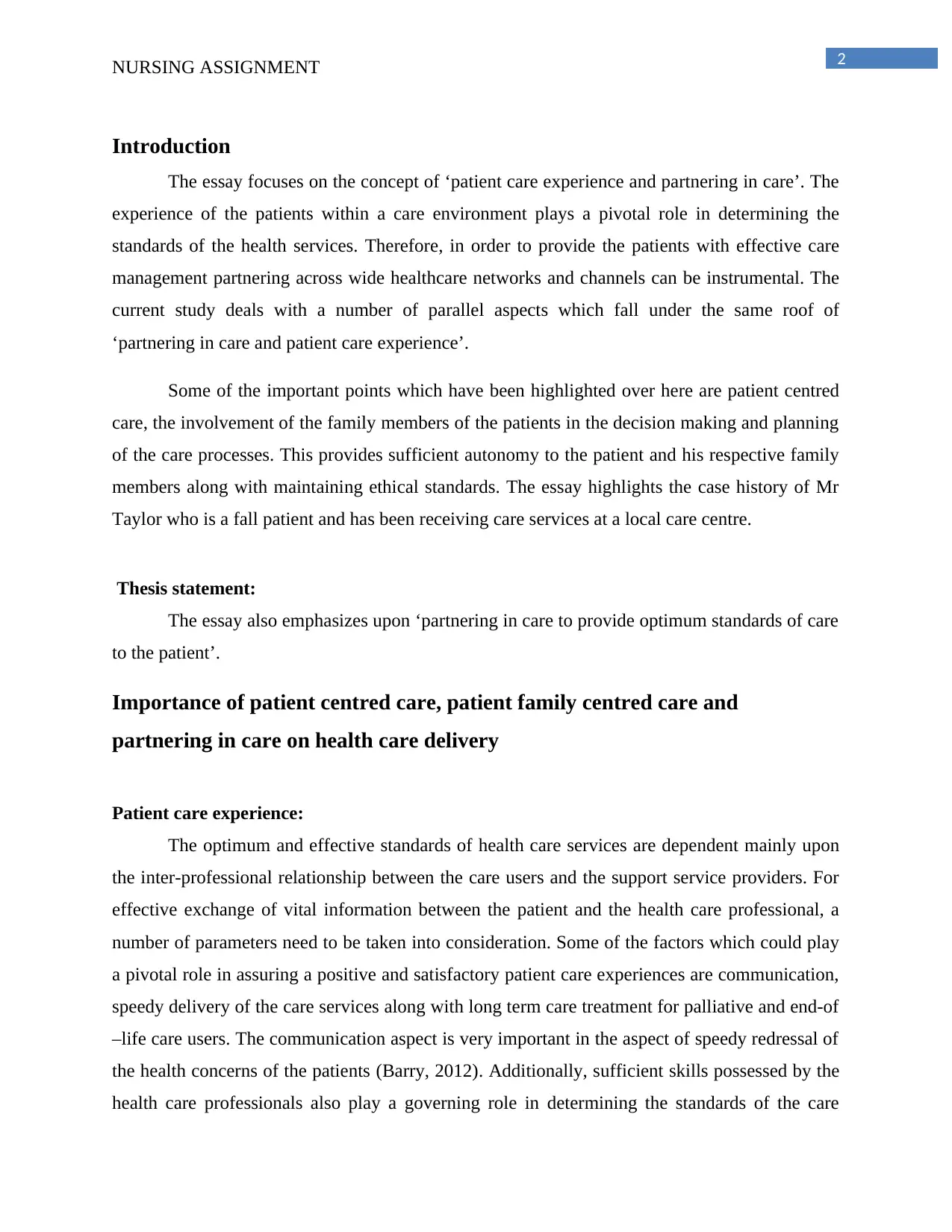
2NURSING ASSIGNMENT
Introduction
The essay focuses on the concept of ‘patient care experience and partnering in care’. The
experience of the patients within a care environment plays a pivotal role in determining the
standards of the health services. Therefore, in order to provide the patients with effective care
management partnering across wide healthcare networks and channels can be instrumental. The
current study deals with a number of parallel aspects which fall under the same roof of
‘partnering in care and patient care experience’.
Some of the important points which have been highlighted over here are patient centred
care, the involvement of the family members of the patients in the decision making and planning
of the care processes. This provides sufficient autonomy to the patient and his respective family
members along with maintaining ethical standards. The essay highlights the case history of Mr
Taylor who is a fall patient and has been receiving care services at a local care centre.
Thesis statement:
The essay also emphasizes upon ‘partnering in care to provide optimum standards of care
to the patient’.
Importance of patient centred care, patient family centred care and
partnering in care on health care delivery
Patient care experience:
The optimum and effective standards of health care services are dependent mainly upon
the inter-professional relationship between the care users and the support service providers. For
effective exchange of vital information between the patient and the health care professional, a
number of parameters need to be taken into consideration. Some of the factors which could play
a pivotal role in assuring a positive and satisfactory patient care experiences are communication,
speedy delivery of the care services along with long term care treatment for palliative and end-of
–life care users. The communication aspect is very important in the aspect of speedy redressal of
the health concerns of the patients (Barry, 2012). Additionally, sufficient skills possessed by the
health care professionals also play a governing role in determining the standards of the care
Introduction
The essay focuses on the concept of ‘patient care experience and partnering in care’. The
experience of the patients within a care environment plays a pivotal role in determining the
standards of the health services. Therefore, in order to provide the patients with effective care
management partnering across wide healthcare networks and channels can be instrumental. The
current study deals with a number of parallel aspects which fall under the same roof of
‘partnering in care and patient care experience’.
Some of the important points which have been highlighted over here are patient centred
care, the involvement of the family members of the patients in the decision making and planning
of the care processes. This provides sufficient autonomy to the patient and his respective family
members along with maintaining ethical standards. The essay highlights the case history of Mr
Taylor who is a fall patient and has been receiving care services at a local care centre.
Thesis statement:
The essay also emphasizes upon ‘partnering in care to provide optimum standards of care
to the patient’.
Importance of patient centred care, patient family centred care and
partnering in care on health care delivery
Patient care experience:
The optimum and effective standards of health care services are dependent mainly upon
the inter-professional relationship between the care users and the support service providers. For
effective exchange of vital information between the patient and the health care professional, a
number of parameters need to be taken into consideration. Some of the factors which could play
a pivotal role in assuring a positive and satisfactory patient care experiences are communication,
speedy delivery of the care services along with long term care treatment for palliative and end-of
–life care users. The communication aspect is very important in the aspect of speedy redressal of
the health concerns of the patients (Barry, 2012). Additionally, sufficient skills possessed by the
health care professionals also play a governing role in determining the standards of the care
⊘ This is a preview!⊘
Do you want full access?
Subscribe today to unlock all pages.

Trusted by 1+ million students worldwide
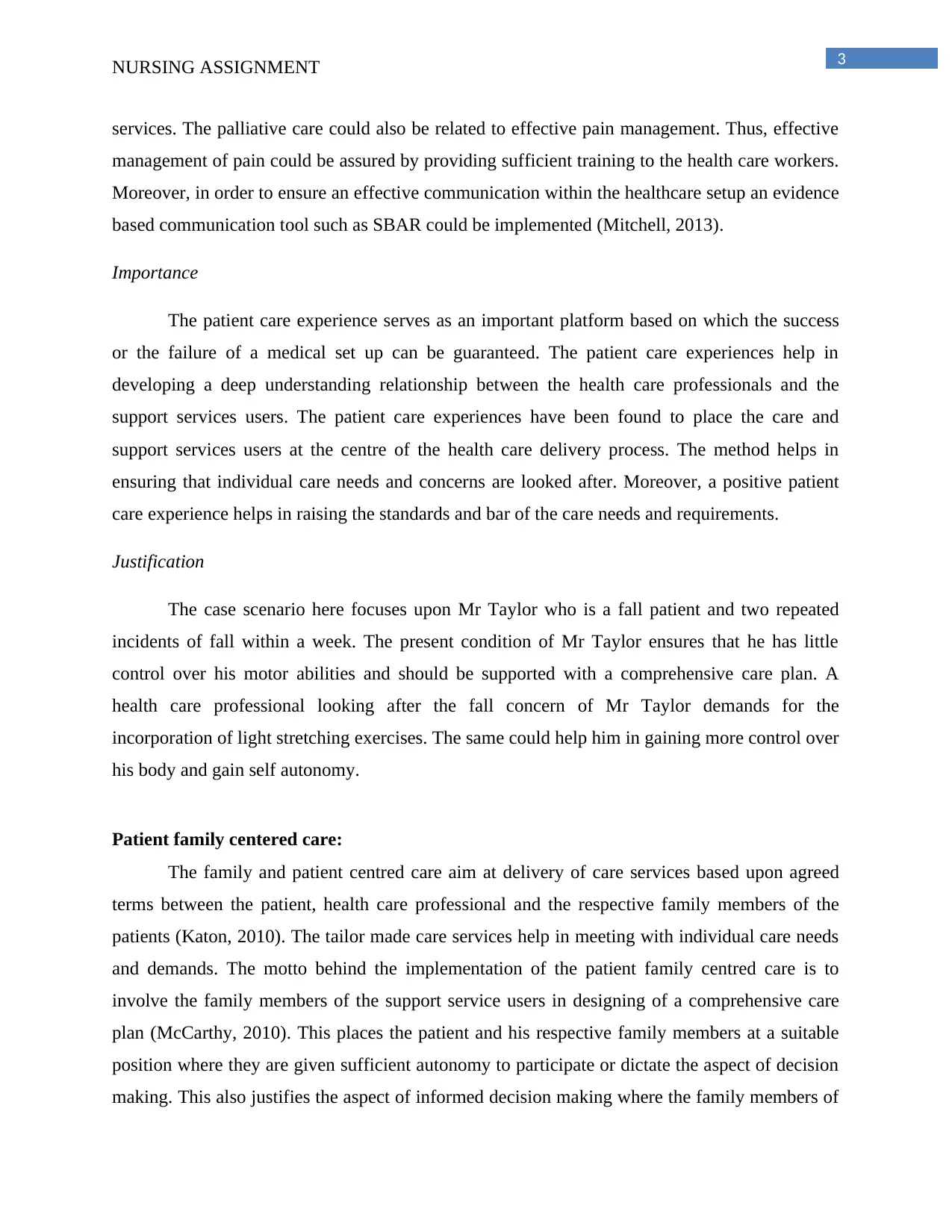
3NURSING ASSIGNMENT
services. The palliative care could also be related to effective pain management. Thus, effective
management of pain could be assured by providing sufficient training to the health care workers.
Moreover, in order to ensure an effective communication within the healthcare setup an evidence
based communication tool such as SBAR could be implemented (Mitchell, 2013).
Importance
The patient care experience serves as an important platform based on which the success
or the failure of a medical set up can be guaranteed. The patient care experiences help in
developing a deep understanding relationship between the health care professionals and the
support services users. The patient care experiences have been found to place the care and
support services users at the centre of the health care delivery process. The method helps in
ensuring that individual care needs and concerns are looked after. Moreover, a positive patient
care experience helps in raising the standards and bar of the care needs and requirements.
Justification
The case scenario here focuses upon Mr Taylor who is a fall patient and two repeated
incidents of fall within a week. The present condition of Mr Taylor ensures that he has little
control over his motor abilities and should be supported with a comprehensive care plan. A
health care professional looking after the fall concern of Mr Taylor demands for the
incorporation of light stretching exercises. The same could help him in gaining more control over
his body and gain self autonomy.
Patient family centered care:
The family and patient centred care aim at delivery of care services based upon agreed
terms between the patient, health care professional and the respective family members of the
patients (Katon, 2010). The tailor made care services help in meeting with individual care needs
and demands. The motto behind the implementation of the patient family centred care is to
involve the family members of the support service users in designing of a comprehensive care
plan (McCarthy, 2010). This places the patient and his respective family members at a suitable
position where they are given sufficient autonomy to participate or dictate the aspect of decision
making. This also justifies the aspect of informed decision making where the family members of
services. The palliative care could also be related to effective pain management. Thus, effective
management of pain could be assured by providing sufficient training to the health care workers.
Moreover, in order to ensure an effective communication within the healthcare setup an evidence
based communication tool such as SBAR could be implemented (Mitchell, 2013).
Importance
The patient care experience serves as an important platform based on which the success
or the failure of a medical set up can be guaranteed. The patient care experiences help in
developing a deep understanding relationship between the health care professionals and the
support services users. The patient care experiences have been found to place the care and
support services users at the centre of the health care delivery process. The method helps in
ensuring that individual care needs and concerns are looked after. Moreover, a positive patient
care experience helps in raising the standards and bar of the care needs and requirements.
Justification
The case scenario here focuses upon Mr Taylor who is a fall patient and two repeated
incidents of fall within a week. The present condition of Mr Taylor ensures that he has little
control over his motor abilities and should be supported with a comprehensive care plan. A
health care professional looking after the fall concern of Mr Taylor demands for the
incorporation of light stretching exercises. The same could help him in gaining more control over
his body and gain self autonomy.
Patient family centered care:
The family and patient centred care aim at delivery of care services based upon agreed
terms between the patient, health care professional and the respective family members of the
patients (Katon, 2010). The tailor made care services help in meeting with individual care needs
and demands. The motto behind the implementation of the patient family centred care is to
involve the family members of the support service users in designing of a comprehensive care
plan (McCarthy, 2010). This places the patient and his respective family members at a suitable
position where they are given sufficient autonomy to participate or dictate the aspect of decision
making. This also justifies the aspect of informed decision making where the family members of
Paraphrase This Document
Need a fresh take? Get an instant paraphrase of this document with our AI Paraphraser
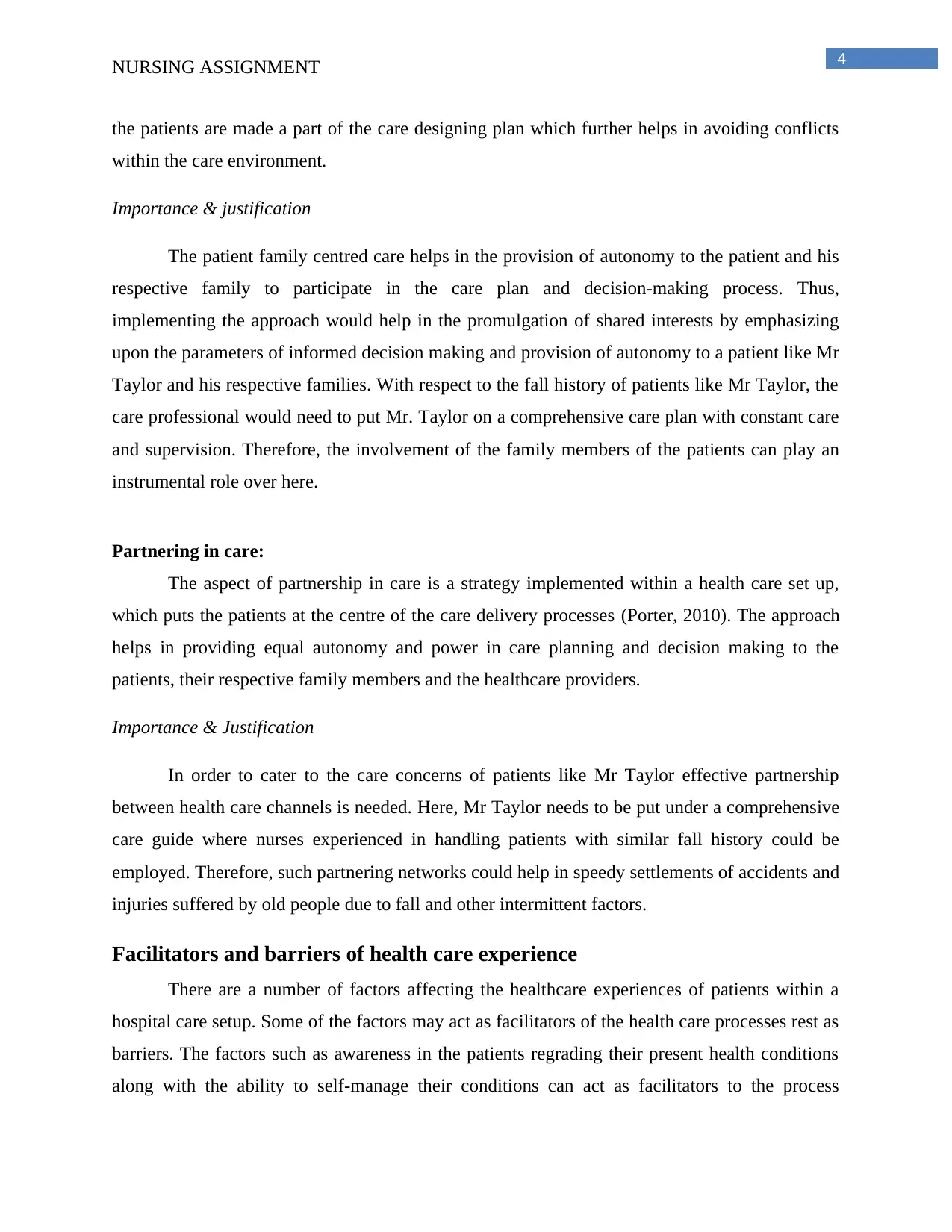
4NURSING ASSIGNMENT
the patients are made a part of the care designing plan which further helps in avoiding conflicts
within the care environment.
Importance & justification
The patient family centred care helps in the provision of autonomy to the patient and his
respective family to participate in the care plan and decision-making process. Thus,
implementing the approach would help in the promulgation of shared interests by emphasizing
upon the parameters of informed decision making and provision of autonomy to a patient like Mr
Taylor and his respective families. With respect to the fall history of patients like Mr Taylor, the
care professional would need to put Mr. Taylor on a comprehensive care plan with constant care
and supervision. Therefore, the involvement of the family members of the patients can play an
instrumental role over here.
Partnering in care:
The aspect of partnership in care is a strategy implemented within a health care set up,
which puts the patients at the centre of the care delivery processes (Porter, 2010). The approach
helps in providing equal autonomy and power in care planning and decision making to the
patients, their respective family members and the healthcare providers.
Importance & Justification
In order to cater to the care concerns of patients like Mr Taylor effective partnership
between health care channels is needed. Here, Mr Taylor needs to be put under a comprehensive
care guide where nurses experienced in handling patients with similar fall history could be
employed. Therefore, such partnering networks could help in speedy settlements of accidents and
injuries suffered by old people due to fall and other intermittent factors.
Facilitators and barriers of health care experience
There are a number of factors affecting the healthcare experiences of patients within a
hospital care setup. Some of the factors may act as facilitators of the health care processes rest as
barriers. The factors such as awareness in the patients regrading their present health conditions
along with the ability to self-manage their conditions can act as facilitators to the process
the patients are made a part of the care designing plan which further helps in avoiding conflicts
within the care environment.
Importance & justification
The patient family centred care helps in the provision of autonomy to the patient and his
respective family to participate in the care plan and decision-making process. Thus,
implementing the approach would help in the promulgation of shared interests by emphasizing
upon the parameters of informed decision making and provision of autonomy to a patient like Mr
Taylor and his respective families. With respect to the fall history of patients like Mr Taylor, the
care professional would need to put Mr. Taylor on a comprehensive care plan with constant care
and supervision. Therefore, the involvement of the family members of the patients can play an
instrumental role over here.
Partnering in care:
The aspect of partnership in care is a strategy implemented within a health care set up,
which puts the patients at the centre of the care delivery processes (Porter, 2010). The approach
helps in providing equal autonomy and power in care planning and decision making to the
patients, their respective family members and the healthcare providers.
Importance & Justification
In order to cater to the care concerns of patients like Mr Taylor effective partnership
between health care channels is needed. Here, Mr Taylor needs to be put under a comprehensive
care guide where nurses experienced in handling patients with similar fall history could be
employed. Therefore, such partnering networks could help in speedy settlements of accidents and
injuries suffered by old people due to fall and other intermittent factors.
Facilitators and barriers of health care experience
There are a number of factors affecting the healthcare experiences of patients within a
hospital care setup. Some of the factors may act as facilitators of the health care processes rest as
barriers. The factors such as awareness in the patients regrading their present health conditions
along with the ability to self-manage their conditions can act as facilitators to the process
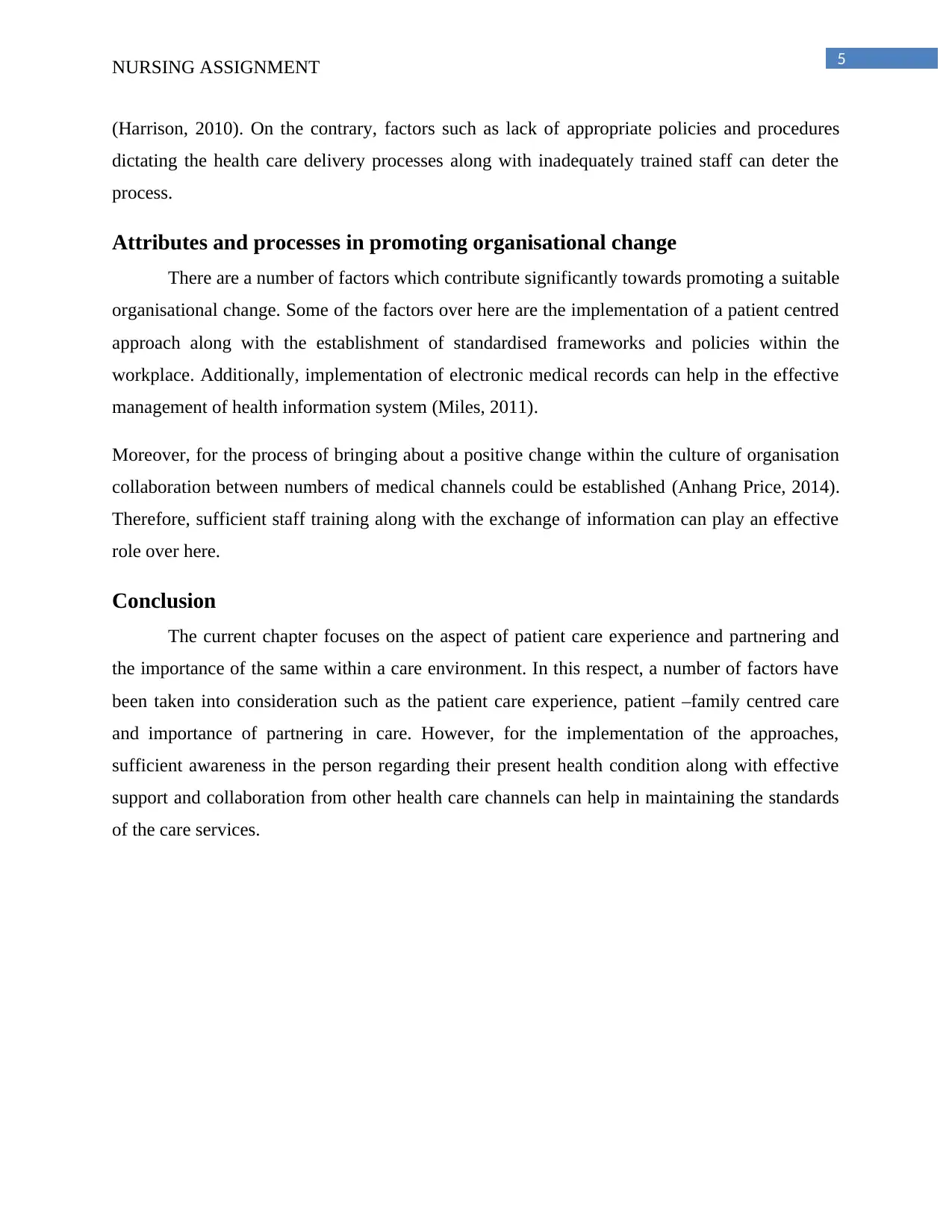
5NURSING ASSIGNMENT
(Harrison, 2010). On the contrary, factors such as lack of appropriate policies and procedures
dictating the health care delivery processes along with inadequately trained staff can deter the
process.
Attributes and processes in promoting organisational change
There are a number of factors which contribute significantly towards promoting a suitable
organisational change. Some of the factors over here are the implementation of a patient centred
approach along with the establishment of standardised frameworks and policies within the
workplace. Additionally, implementation of electronic medical records can help in the effective
management of health information system (Miles, 2011).
Moreover, for the process of bringing about a positive change within the culture of organisation
collaboration between numbers of medical channels could be established (Anhang Price, 2014).
Therefore, sufficient staff training along with the exchange of information can play an effective
role over here.
Conclusion
The current chapter focuses on the aspect of patient care experience and partnering and
the importance of the same within a care environment. In this respect, a number of factors have
been taken into consideration such as the patient care experience, patient –family centred care
and importance of partnering in care. However, for the implementation of the approaches,
sufficient awareness in the person regarding their present health condition along with effective
support and collaboration from other health care channels can help in maintaining the standards
of the care services.
(Harrison, 2010). On the contrary, factors such as lack of appropriate policies and procedures
dictating the health care delivery processes along with inadequately trained staff can deter the
process.
Attributes and processes in promoting organisational change
There are a number of factors which contribute significantly towards promoting a suitable
organisational change. Some of the factors over here are the implementation of a patient centred
approach along with the establishment of standardised frameworks and policies within the
workplace. Additionally, implementation of electronic medical records can help in the effective
management of health information system (Miles, 2011).
Moreover, for the process of bringing about a positive change within the culture of organisation
collaboration between numbers of medical channels could be established (Anhang Price, 2014).
Therefore, sufficient staff training along with the exchange of information can play an effective
role over here.
Conclusion
The current chapter focuses on the aspect of patient care experience and partnering and
the importance of the same within a care environment. In this respect, a number of factors have
been taken into consideration such as the patient care experience, patient –family centred care
and importance of partnering in care. However, for the implementation of the approaches,
sufficient awareness in the person regarding their present health condition along with effective
support and collaboration from other health care channels can help in maintaining the standards
of the care services.
⊘ This is a preview!⊘
Do you want full access?
Subscribe today to unlock all pages.

Trusted by 1+ million students worldwide
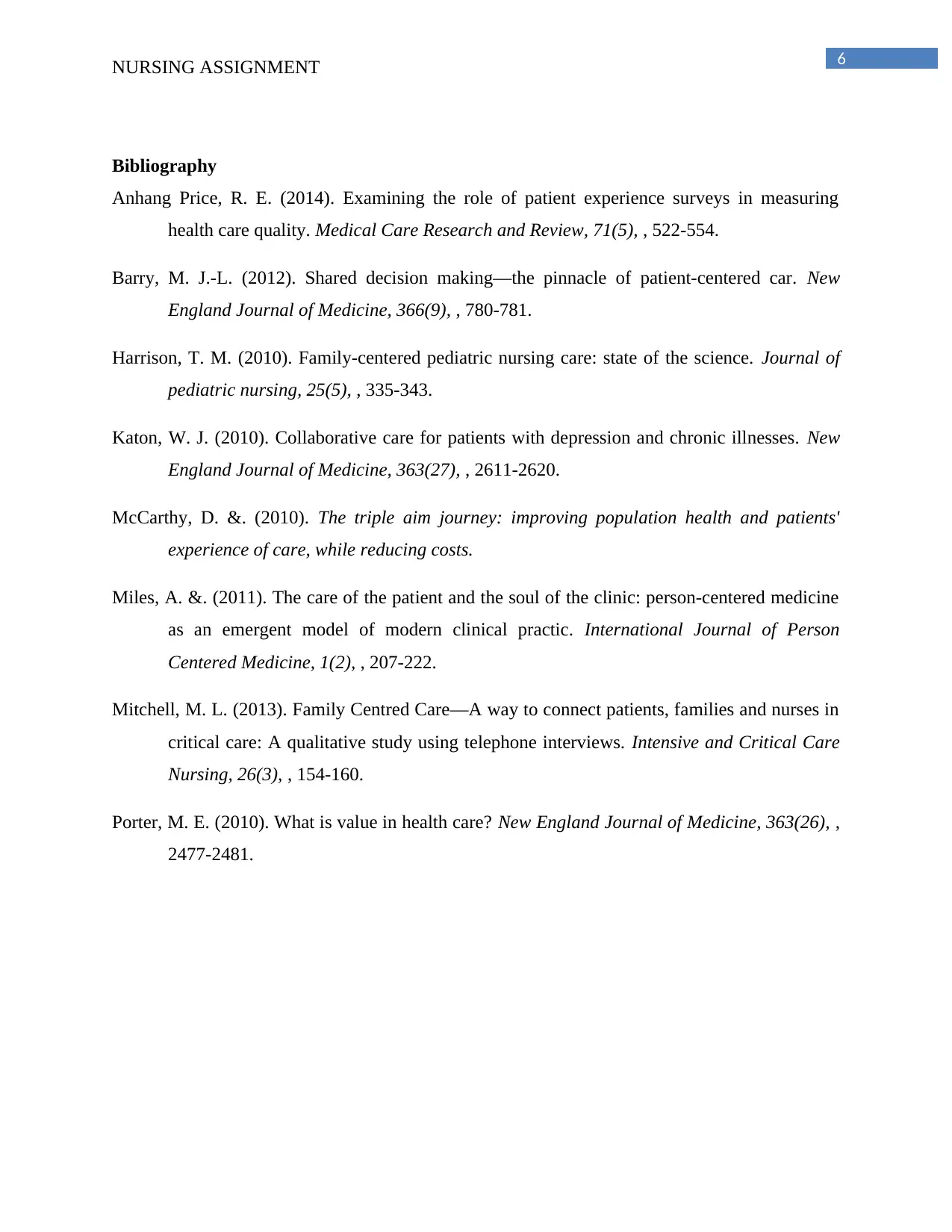
6NURSING ASSIGNMENT
Bibliography
Anhang Price, R. E. (2014). Examining the role of patient experience surveys in measuring
health care quality. Medical Care Research and Review, 71(5), , 522-554.
Barry, M. J.-L. (2012). Shared decision making—the pinnacle of patient-centered car. New
England Journal of Medicine, 366(9), , 780-781.
Harrison, T. M. (2010). Family-centered pediatric nursing care: state of the science. Journal of
pediatric nursing, 25(5), , 335-343.
Katon, W. J. (2010). Collaborative care for patients with depression and chronic illnesses. New
England Journal of Medicine, 363(27), , 2611-2620.
McCarthy, D. &. (2010). The triple aim journey: improving population health and patients'
experience of care, while reducing costs.
Miles, A. &. (2011). The care of the patient and the soul of the clinic: person-centered medicine
as an emergent model of modern clinical practic. International Journal of Person
Centered Medicine, 1(2), , 207-222.
Mitchell, M. L. (2013). Family Centred Care—A way to connect patients, families and nurses in
critical care: A qualitative study using telephone interviews. Intensive and Critical Care
Nursing, 26(3), , 154-160.
Porter, M. E. (2010). What is value in health care? New England Journal of Medicine, 363(26), ,
2477-2481.
Bibliography
Anhang Price, R. E. (2014). Examining the role of patient experience surveys in measuring
health care quality. Medical Care Research and Review, 71(5), , 522-554.
Barry, M. J.-L. (2012). Shared decision making—the pinnacle of patient-centered car. New
England Journal of Medicine, 366(9), , 780-781.
Harrison, T. M. (2010). Family-centered pediatric nursing care: state of the science. Journal of
pediatric nursing, 25(5), , 335-343.
Katon, W. J. (2010). Collaborative care for patients with depression and chronic illnesses. New
England Journal of Medicine, 363(27), , 2611-2620.
McCarthy, D. &. (2010). The triple aim journey: improving population health and patients'
experience of care, while reducing costs.
Miles, A. &. (2011). The care of the patient and the soul of the clinic: person-centered medicine
as an emergent model of modern clinical practic. International Journal of Person
Centered Medicine, 1(2), , 207-222.
Mitchell, M. L. (2013). Family Centred Care—A way to connect patients, families and nurses in
critical care: A qualitative study using telephone interviews. Intensive and Critical Care
Nursing, 26(3), , 154-160.
Porter, M. E. (2010). What is value in health care? New England Journal of Medicine, 363(26), ,
2477-2481.
1 out of 7
Related Documents
Your All-in-One AI-Powered Toolkit for Academic Success.
+13062052269
info@desklib.com
Available 24*7 on WhatsApp / Email
![[object Object]](/_next/static/media/star-bottom.7253800d.svg)
Unlock your academic potential
Copyright © 2020–2025 A2Z Services. All Rights Reserved. Developed and managed by ZUCOL.





